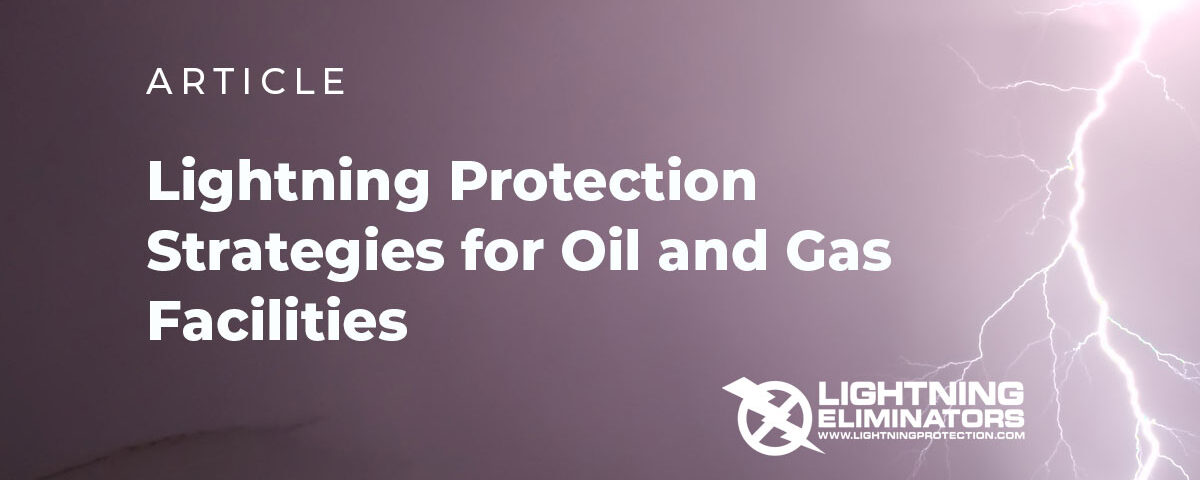- We Prevent Lightning Related Problems.

Video: RGA-750 | Retractable Grounding Assembly for Floating Roof Tanks
April 2, 2025Lightning Protection Strategies for Oil and Gas Facilities

The COMPLETE version of this article, written by Jeff Elliott, first appeared in Facility Executive Magazine
Oil and gas facilities, including refineries, produced water/Saltwater Disposal (SWD) facilities, upstream/midstream operations, and petrochemical plants, are highly vulnerable to fires, explosions, and operational disruptions caused by lightning strikes. Even in areas with infrequent thunderstorms, severe lightning events can lead to catastrophic damage, injury, downtime, fines, and negative impacts on corporate reputation.
The financial consequences of lightning strikes in industrial settings can be devastating, igniting fires, destroying assets, and causing costly downtime and environmental damage. This has led many oil and gas facilities to adopt lightning defense strategies to protect structures, equipment, and personnel. Lightning defense encompasses two key approaches: lightning protection and lightning avoidance, such as Charge Transfer technologies. Proper grounding and surge protection are also critical.
Mounting an effective defense against lightning-related threats typically requires a tailored strategy that integrates multiple solutions. Engaging qualified lightning protection experts for thorough site evaluations, identifying vulnerabilities, and recommending appropriate protection solutions is essential. A tailored evaluation by qualified experts can safeguard critical infrastructure and personnel and prevent costly disruptions.
Oil and gas facilities are particularly vulnerable to lightning strikes due to factors such as their location in open or elevated areas, the presence of tall steel structures, and the presence of flammable gases and liquids. Modern oil and gas operations rely on complex electrical and control systems, which are sensitive to voltage surges. Operational downtime and process upsets can cause cascading issues, leading to significant financial losses. Safety is a major driver for investment in lightning protection, as lightning strikes can result in serious injuries to plant personnel.
Comprehensive lightning protection systems are critical in safeguarding oil and gas facilities from structural damage, catastrophic safety incidents, unplanned downtime, and expensive process restarts. The appropriate combination of solutions can only be determined through a comprehensive evaluation of each facility’s current protection measures, grounding systems, and overall risk exposure. LEC helps facilities identify vulnerabilities and implement customized mitigation strategies.
The Dissipation Array System® (DAS®) from LEC is designed to prevent direct lightning strikes within its designated protection area by lowering the electric field to levels below those required for lightning to form. DAS can be integrated with a wide range of structures, including buildings, towers, tanks, and stacks. The effectiveness of DAS is enhanced when combined with a comprehensive lightning protection system that includes a low-impedance grounding system, transient voltage surge suppression, and modular strike prevention devices.
Proper bonding and grounding solutions are critical for prevention. The Retractable Grounding Assembly (RGA) is an advanced lightning protection device developed by LEC to safeguard floating roof storage tanks from lightning-induced fires. The In-Tank Potential Equalizer (IPE) can be submerged in the liquid in the tank to provide a conductive path for the charge accumulated on the fluid to safely dissipate to the ground.
To ensure maximum safety, reliability, and operational continuity, facilities are strongly encouraged to schedule a professional site assessment 20. This proactive step helps prevent costly disruptions and reinforces a facility’s long-term resilience against lightning-related threats.

